Naming the best Roman Emperor is like naming your favorite vacation destination. It depends on a lot of factors and it’s completely subjective. Here, I list the best Roman emperors based on their good deeds and the favorable impact they had on the Empire. While I feel this is a daunting task, I am up for the challenge. Are you?
Pro Tip: History geek planning what to do on your trip to Rome? Bookmark this post in your browser so you can easily find it when you’re in the city. See our guide to Rome for more planning resources, our top Rome tours for a memorable trip, and how to see Rome in a day.
The Top 10 Greatest Roman Emperors of Antiquity
For me, Ancient Rome is one of the most fascinating periods in history. From the founding story with Romulus to the fall of the Western Roman Empire almost 1,000 years later, it’s all very interesting!
I fully admit that I’m only scratching the surface here, so check out our Rome Guide for more history articles. Here are my selections for the greatest ancient Roman emperors and why.
Not ready to book a tour? See if Rome tours are worth it.
10. Septimius Severus
Emperor A.D. 193 – 211
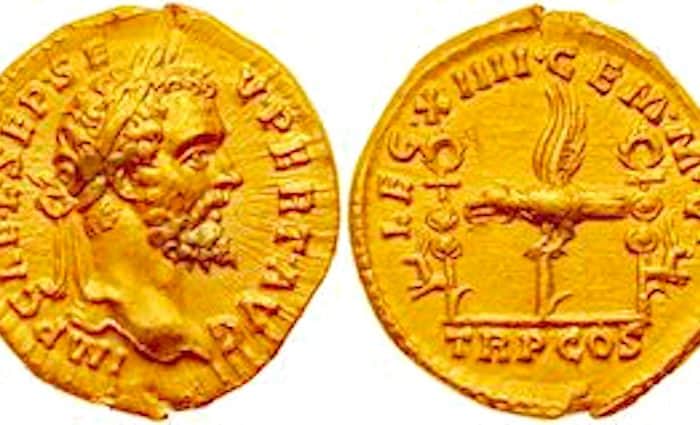
The first Roman Emperor from Africa (modern-day Libya), Septimius Severus, rose to power during the unstable period of the late second century. In this era, assassinations and coups were quite normal.
His main claim to fame was re-establishing Roman control over Parthia (modern-day Iran). This was sweet revenge for the Romans since they had lost a huge battle to the Parthians under General Crassus in 53 B.C. To punish Crassus for his greed, the Parthians killed him by pouring molten gold down his throat.
When Septimius Severus returned from his victory, the Senate built a huge triumphal arch in his honor. You can still see it today in the Roman Forum.
Military Conquests:
- A.D. 197 – Parthia (Modern Day Iran)
- A.D. 199 – Mesopotamia
Major Construction and Public Works:
Mostly repairs and upgrades to existing structures with the exception of the Arch of Septimius Severus which is one of few remaining arches today.
- Palatine Palace Extensions
- A.D. 192 – Temple of Peace (repairs)
- A.D. 203 – Septizodium: Facade of Palatine hill facing Appian way approach.
- Early C3 – Castra Nova: Barracks for expanding cavalry guard under modern-day St. John Lateran Church.
- Pre A.D. 210 – Arch of Septimius Severus
9. Aurelian
Emperor A.D. 270 – 275
One of the lesser-known emperors, but still one of the greats, Aurelian took over as emperor in the late third century A.D. Besides his great military conquests, he is most remembered for building the Aurelian Wall.
It still surrounds most of Rome today and is extremely impressive. The wall bought Rome another hundred or so years of safety. They were (and still are) 11 feet (3.5 meters) thick and 25 feet (8 meters) tall with guard towers every 100 feet (29.6 meters).
Military Conquests:
Mostly defensive campaigns as the empire was expanded to the max at this point but some significant victories nonetheless.
- A.D. 270 – Expelled Vandals, Goths, and Juthungi
- A.D. 272 – Conquest of Palmyrene Empire: Achieved significant territory in the middle east.
- A.D. 274 – Reconquest of Gaul: Retaking of lost ground in modern-day France and Britain.
Major Construction and Public Works:
- A.D. 271 to 275 – Aurelian Walls
Not ready to book a tour? Check out our best Rome tours to take and why.
8. Vespasian Flavian
Emperor A.D. 69 – 79
He became emperor after the crazy year of ’68 when three emperors ruled and were disposed in the same year. This stoic man was all about creating order. He was the first of the Flavian dynasty, which included himself, Titus, and Domitian.
Titus did not get much time as emperor but was an accomplished general and warlord. He quelled a revolt in Jerusalem, bringing back thousands of slaves who would build the Colosseum and fortunes unmatched by any other general.
Vespasian was so eager to collect money in taxes, he imposed a tax on the urine collectors for saying “money doesn’t smell.” Oh, yeah! He also built that iconic structure we all know as the Colosseum.
The structure was no easy task either. Nero had created a lake in the valley that is now home to the Colosseum and lakes do not make great places to build stadiums. That said, Vespasian’s great amphitheater has endured the test of time.
Military Conquests:
- A.D. 66 – First Revolt of the Jews; as General.
- A.D. 70 – Siege of Jerusalem aka 2nd Revolt of the Jews; as Emperor
Major Construction and Public Works:
- A.D. 71 – Aqua Claudia: Repairs
- A.D. 70s Caelian Aqueduct: Extension of Aqua Claudia carrying water to southern parts of Rome
- Early A.D. 70s – Temple of Deified Claudius: Nero stopped the original construction by his mother Agrippa the Younger after murdering her. Vespasian restarted the temple completing it in the early years of his reign.
- A.D. 79 – Flavian Amphitheater: the Colosseum. Additional construction was started under Titus and completed by Domitian.
7. Constantine
Emperor A.D. 280 – 337
Constantine was a product of his Christian mother Helen and will forever be known as the man who legalized Christianity with the signing of the Edict of Milan. He himself was pagan most of his life but must have seen the changing of the tides and did not fight it. In the end, he persevered and earned himself the empire.
The night before the battle of Milvian Bridge on north Via Flaminia, he saw a vision of a cross in the sky. He used the vision as the motivation for his troops he went on to conquer paganism. As a result of his victory in the ensuing battle, he legalized this once-outlawed fringe religion. Today, we know it as Christianity!
As heroic as it sounds, this led to years of in-fighting between Christian and pagan Romans. Christians are said to have instigated heavily due to not accepting pagans’ freedom of belief.
Military Conquests:
- A.D. 306-8 – Alamanni
- A.D. 312 – Battle of Milvian Bridge: Lead to the legalization of Christianity A.D. 313.
- A.D. 332 – Visigoths
- A.D. 334 – Sarmatians
Major Construction and Public Works:
- A.D. 313 – New Basilica (Temple of Maxentius now Basilica of Constantine): Massive construction that can still be seen in part today.
- A.D. 315 – Arch of Constantine
- Early fourth century A.D. – St Peter’s Basilica (Old)
6. Nerva
Emperor A.D. 96 – 98
Similar to Vespasian, he inherited an empire in chaos after the wacko Emperor Domitian filled the empire with fear. He revised the taxes in favor of the poor, but his best deed as emperor was to adopt Trajan and name him a successor.
This was important because he wasn’t his blood relative and, in doing so, stopped the family dynasty and set up a golden age in Rome that would last almost 100 years.
5. Antonino Pio
Emperor A.D. 138 – 161
Elected emperor at the age of 51, he ruled until he was 74 years old. Amazingly, his reign was quiet. This is why he ranks at number five.
With no turmoil, no costly war, and no famous coup d’etat, Antonino Pio was just a good man running the Roman Empire. And remember, the Roman Empire constituted most of the Western Civilization at the time.
Major Construction and Public Works:
- Column of Antonius Pius
- A.D.140 – Temple of Diva Faustina (later Diva Antonius Pius and Faustina)
4. Marcus Aurelius
Emperor A.D. 121 – 180
He spent most of his career as emperor on the military trail in Germania (located around modern-day Germany). While his most famous claim to fame is immortalized in the movie “Gladiator,” he was also an efficient ruler and administrator. However, his only downfall was choosing his son Commodus as the next emperor. From there, it all went downhill.
Military Conquests:
- A.D. 161 – Parthia
- A.D. 166 to 180 – Germania
3. Octavian, aka Augustus
Emperor 27 B.C. – A.D. 14
Now pretty much all the emperors were called Augustus, but this was the first one. He bridged the period between the waning days of the Republic and the beginning of the glory days of the Empire.
He started the Julio-Claudian Dynasty and is responsible for the PAX ROMANA—Peace throughout the Roman Empire. Ironically, it’s believed that he was poisoned to death at the hands of his wife.
Major Construction and Public Works:
- Forum of Augustus
- 2 B.C. – Naumachia
- Temple of Apollo
- Temple of Jupiter
- Theatre of Marcellus
- Senate House
- Forum of Caesar
2. Hadrian
Emperor A.D. 117 – 134
Of all the best Roman emperors, none is more represented in the ruins of the once-powerful Roman Empire. We have Hadrian’s Wall in England, Hadrian’s Temple in Ephesus, Hadrian’s Arch in Athens, and Hadrian’s Tomb and Temple in Rome. In addition, the Pantheon in Rome is also attributed to Hadrian.
He loved traveling around the empire, was a huge grecophile, and is known for loving a Bithynian Greek youth named Antinous. When Antinous mysteriously drowned in the Nile, he made him a god and named a city after him called Antinopolis. If that’s not love, nothing is!
Military Conquests:
While Hadrian did spend much of his time on the road campaigning with the military, he partook in mostly peacekeeping talks. He was considered a great military mind but in true Roman fashion, he preferred to assimilate rather than force nations to join Rome.
- A.D. 136 – Second Jewish War
Major Construction and Public Works:
- A.D. 122 – Hadrian’s Wall: Iconic wall in Britain that extends from the Irish Seat to the North Sea.
- A.D. 125 – The Pantheon: Considered the best preserved ancient structure in Rome and arguably on Earth.
- A.D. 126 – Temple of Deified Trajan
- A.D. 135 – Temple of Rome and Venus
- A.D. 139 – Mausoleum of Hadrian: Modern day Castel Sant Angelo
Popular Tours from Rome
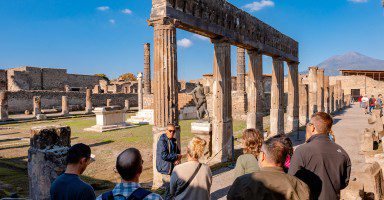
Best Seller
Unforgettable Rome Day Trip to Pompeii and Sorrento
Making a day trip from Rome to Pompeii and the Amalfi Coast can be daunting, with long travel times, complex routes, and tricky logistics to manage. Our full-day tour eliminates the stress, offering comfortbale transport straight to Pompeii. With an archaeologist guide, explore the ancient ruins without the hassle. Then, unwind with free time in Sorrento’s coastal charm. Led by a local guide and small group, this trip makes experiencing Italy’s highlights easy and enjoyable—all in one day.
See prices and more info
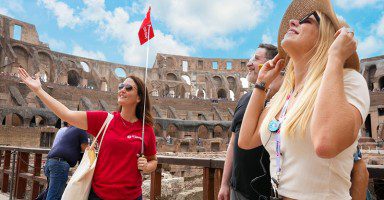
Best Seller
Rome in a Day Tour with Colosseum & Vatican Museums
Seeing the best of Rome in a single day might seem like a big undertaking, but our expertly designed tour makes it effortless with skip-the-line tickets, included transportation, and engaging guides to lead the way. In just 7 hours, you’ll visit renowned sites like the Sistine Chapel, Colosseum, Trevi Fountain, and Pantheon. With fascinating stories at every stop, you can skip the stress and immerse yourself in the vibrant heritage and culture of Rome all in one remarkable day.
See prices and more info
Not ready to book a tour? Find out if Rome tours are worth it.
1. Trajan
Emperor A.D. 98 – 117
The first emperor born outside of Italy (in modern-day Spain), Trajan was beloved. The military adored him for the hardships he shared with them, ordinary Romans respected him for his generous welfare program, and the Senate respected him for the consideration he showed them.
Upon his death, his ashes were put in an urn in his column. Trajan’s Column still stands proudly in the center of Rome. A testament to his fame, even two centuries after his death, senators would bless a new emperor by saying, “More fortunate than Augustus, and better than Trajan.” Enough said.
He enlarged the Roman Empire by conquering Dacia (modern-day Romania), which was not easily marched over. It was considered a massive accomplishment and is detailed in his triumphant column.
Military Conquests:
- A.D. 106 – Dacia
Major Construction and Public Works:
- A.D. 118- Trajan’s Column
- A.D. 109 – Aqua Traiana: 32.5km aqueduct from lake Bracciano to Rome.
- Palatine Hill Upgrades
- A.D. 107 to 110 – Trajan’s Market: Massive commercial market with luxury residences
- A.D. 107 to 110 – Trajan’s Forum
Not ready to book a tour? Check out our best Rome tours to take and why.
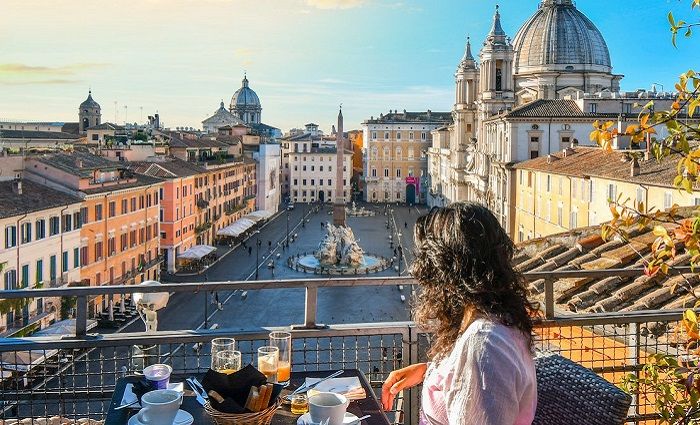
Where To Stay in Rome
Rome has a rich cultural history and many iconic landmarks to explore. Plan where to stay in the magnificent Eternal City in the best neighborhoods.

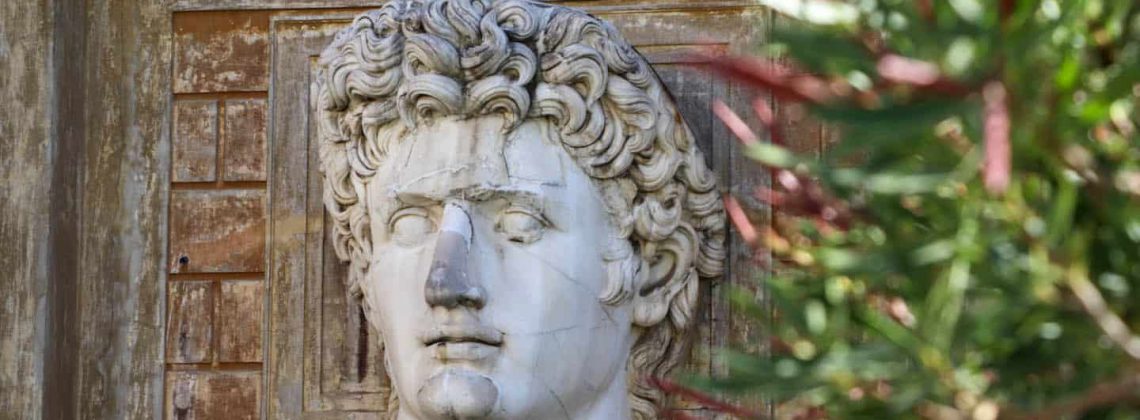
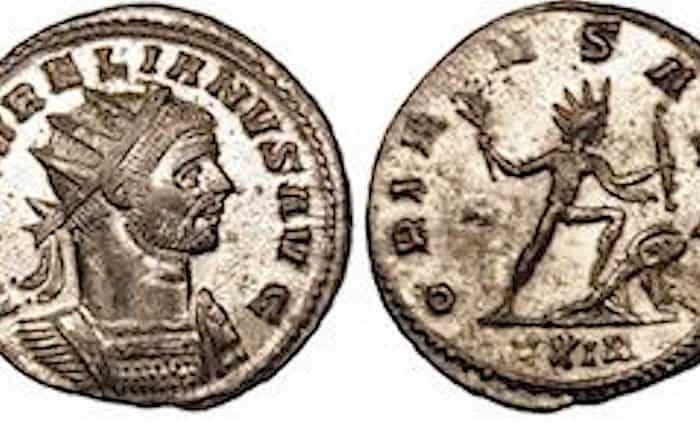
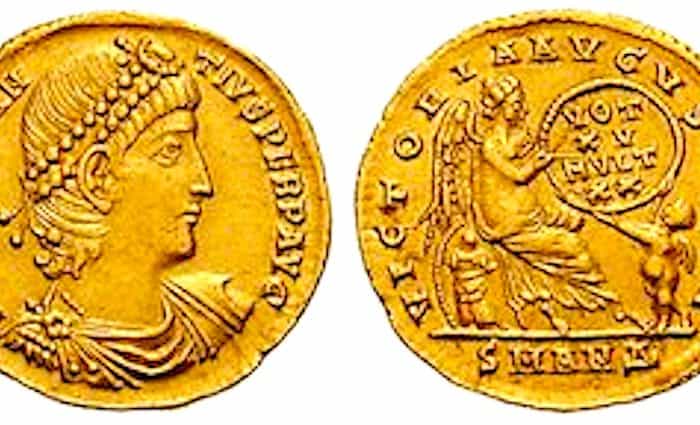
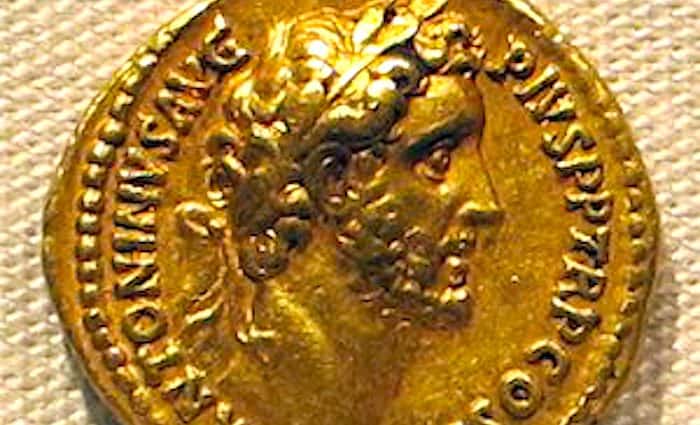
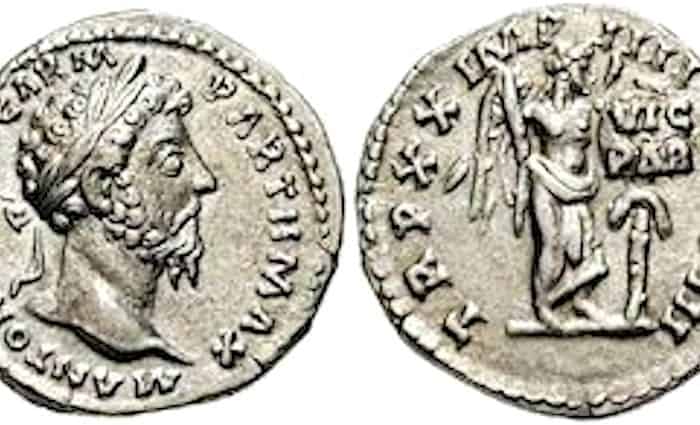
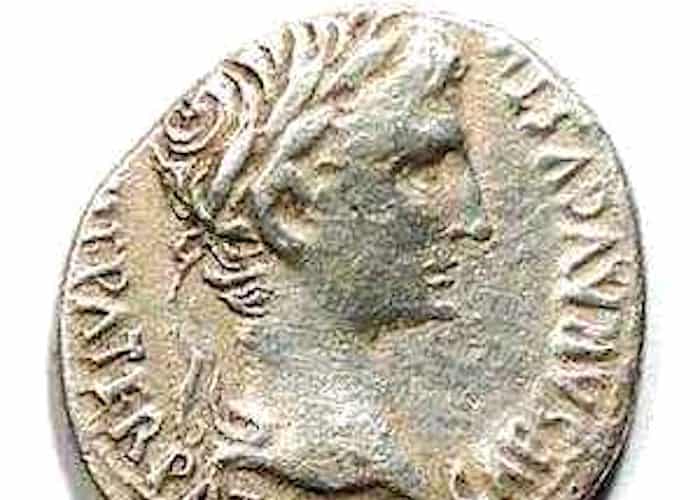
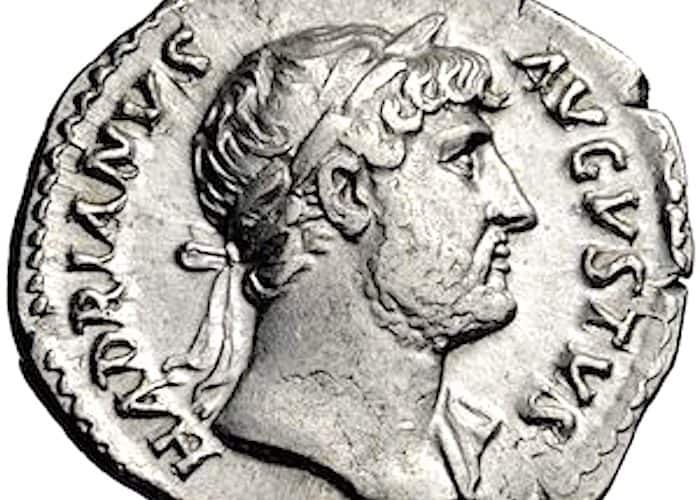
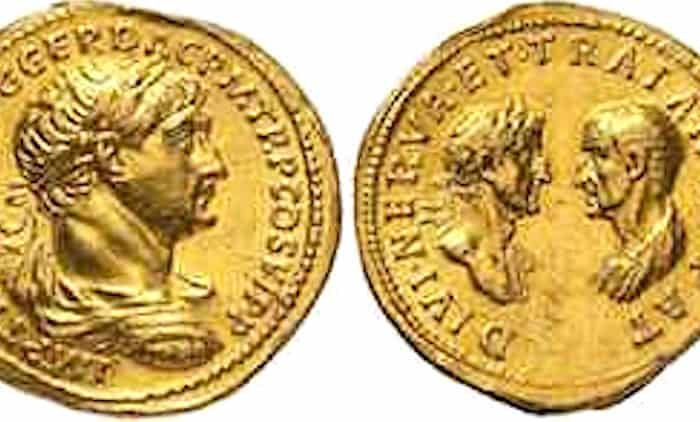
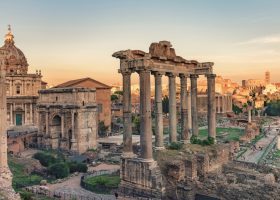
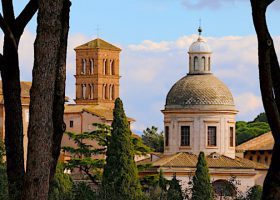
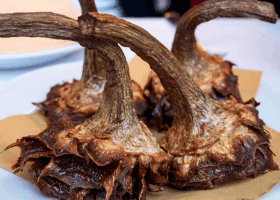
Great article! We will be linking to this particularly great content on our site.
Great list! I agree with most of them! Of course, with such a complex and broad topic you will always have differences of opinion.
Just for argument’s sake, I will throw in another name, quoting an answer that was given on Quora on this same topic: Flavius Petrus Sabbatius Iustinianus (Augustus).
“This one is easy. Flavius Petrus Sabbatius Iustinianus (Augustus), in English known as Justinian I.(reigned 1 August 527 – 14 November 565). He was the greatest legislator of all Roman Emperors, and his magnum opus, Corpus Iuris Civilis, is the basis of the Western jurisprudence even today.
What made him so great? Merely unifying and consolidating the Roman laws and justice would have qualified, but he did far more! Not only did he save the Empire when it was in peril during the Barbarian migrations and internal disputes such as Nika riots, but he also re-conquered several lost provinces, beat the Persians and made peace with them, which lasted for fifty years. He favoured commerce, renewed taxation and started a major building and infrastructure renewal program. The Hagia Sophia Cathedral in Constantinople, today’s Istanbul, is his lasting legacy. He reigned for 38 years, longer than any Roman emperor before him sans Augustus.
At his death, the Eastern Roman Empire covered almost the whole of the area of the Unified Empire, and had expanded to East.
He was the last Emperor who spoke Latin as his mother tongue. During his reign, all the three old Western Imperial capitals, Rome, Mediolanum and Ravenna, were all reconquered and consolidated to the Empire.”
I’m sad you left out Claudius. Also having studied Domitian a little I don’t think it’s fair to dismiss him simply as a “wacko”. Other than that, good stuff.